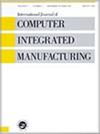Virtual prototyping for the textile industry: a framework supporting the production of crocheted objects
IF 3.7
3区 工程技术
Q2 COMPUTER SCIENCE, INTERDISCIPLINARY APPLICATIONS
International Journal of Computer Integrated Manufacturing
Pub Date : 2023-11-11
DOI:10.1080/0951192x.2023.2278115
引用次数: 0
Abstract
ABSTRACTOver the last years, many progresses have been made in the field of virtual prototyping, pushed by the interest of industries and artisans. Especially in the context of the textile industry, the digitizing of the prototyping stage offers the possibility to validate the product design choices before committing to the market. This paper presents a framework for the virtual prototyping of crocheted objects. The core of the framework is an algorithm that is capable of generating the crocheting patterns for a given object and the corresponding instructions. The instructions are leveraged by the framework to visualize the 3D geometry of the object, and can be also used to craft it. Compared to previous works, the proposed algorithm combines a number of features (primarily, the use of parametric surfaces and the support for short rows) that can reduce the distortions in crafted object shape while also lowering computational cost; the algorithm is also able to consider material- and style-related information. The results of a comparison between the proposed algorithm and state-of-the-art approaches showed improved performance in terms of similarity of the generated shape with the target one, computation time, and appearance of the crafted object.KEYWORDS: Virtual prototypingcrocheting instruction generation algorithmshort rowsdigital craftingparametric design AcknowledgmentsThe authors would like to thank Özgüç Çapunaman, co-author of the reference of work considered in the experimental evaluation, for making available the surfaces used in their research, thus enabling the comparison of achieved results.Disclosure statementThe authors have no relevant financial or non-financial interests to disclose.Author contributorsAll the authors contributed to the study conception and design. The software was developed by Massimo Gismondi, under the supervision of Fabrizio Lamberti and Alberto Cannavò. The experimental analysis was performed by Massimo Gismondi with the support of Alberto Cannavò, and revised by Fabrizio Lamberti. The first draft of the manuscript was written by Alberto Cannavò, and all the authors worked on its revisions. All the authors read and approved the final manuscript.Additional informationFundingResearch was supported by PON “Ricerca e Innovazione” 2014–2020 – DM 1062/2021 funds.纺织工业的虚拟原型:支持钩针编织对象生产的框架
近年来,在工业和工匠的兴趣推动下,虚拟样机领域取得了许多进展。特别是在纺织行业的背景下,原型阶段的数字化提供了在投入市场之前验证产品设计选择的可能性。本文提出了一种用于钩针物品虚拟样机的框架。该框架的核心是一个算法,该算法能够为给定对象生成钩织模式和相应的指令。框架利用这些指令来可视化对象的3D几何形状,也可以用来制作它。与以前的工作相比,所提出的算法结合了许多特征(主要是参数曲面的使用和对短行的支持),可以减少加工对象形状的扭曲,同时降低计算成本;该算法还能够考虑与材料和风格相关的信息。将提出的算法与最先进的方法进行比较的结果表明,在生成的形状与目标形状的相似性、计算时间和制作对象的外观方面,该算法的性能有所提高。关键词:虚拟样机;钩针编织指令生成算法;短行;数字工艺;参数化设计致谢作者要感谢Özgüç Çapunaman,实验评估中考虑的工作参考文献的合著者,他提供了他们研究中使用的表面,从而能够比较取得的结果。作者没有相关的财务或非经济利益需要披露。所有作者都对研究的构思和设计做出了贡献。该软件是由Massimo Gismondi在Fabrizio Lamberti和Alberto Cannavò的监督下开发的。实验分析由Massimo Gismondi在Alberto Cannavò的支持下完成,并由Fabrizio Lamberti修改。手稿的初稿是由Alberto Cannavò写的,所有的作者都在修改它。所有的作者都阅读并批准了最终的手稿。本研究由PON“Ricerca e Innovazione”2014-2020 - 1062/2021马克基金资助。
本文章由计算机程序翻译,如有差异,请以英文原文为准。
求助全文
约1分钟内获得全文
求助全文
来源期刊
CiteScore
9.00
自引率
9.80%
发文量
73
审稿时长
10 months
期刊介绍:
International Journal of Computer Integrated Manufacturing (IJCIM) reports new research in theory and applications of computer integrated manufacturing. The scope spans mechanical and manufacturing engineering, software and computer engineering as well as automation and control engineering with a particular focus on today’s data driven manufacturing. Terms such as industry 4.0, intelligent manufacturing, digital manufacturing and cyber-physical manufacturing systems are now used to identify the area of knowledge that IJCIM has supported and shaped in its history of more than 30 years.
IJCIM continues to grow and has become a key forum for academics and industrial researchers to exchange information and ideas. In response to this interest, IJCIM is now published monthly, enabling the editors to target topical special issues; topics as diverse as digital twins, transdisciplinary engineering, cloud manufacturing, deep learning for manufacturing, service-oriented architectures, dematerialized manufacturing systems, wireless manufacturing and digital enterprise technologies to name a few.

 求助内容:
求助内容: 应助结果提醒方式:
应助结果提醒方式:


